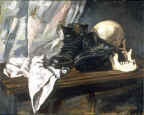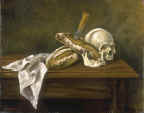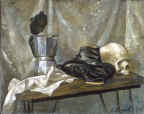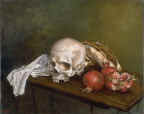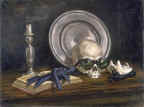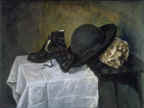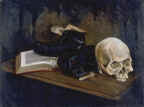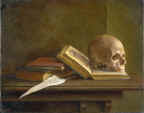| The Vanitas Still Life Series This genre of still life became popular in 17th century Holland emphasizing the transience of life and the evanescence of things. The message found in Ecclesiastes: Vanitas vanitatum, et omnia vanitas (or Vanity of vanities, and all is vanity) made a poignant reminder and meditation for the opulent bourgeois culture which flourished in the Netherlands at that time. Still-lifes depicting a skull and the objects of daily life became as standard a piece of interior decoration as the sumptuous pictures of flower arrangements, or assortments of gourmet delicacies displayed like jewels amongst fine crystal and silverware (called Pronck still-life). I have been interested in the genre not only for its philosophical and metaphysical possibilities, but also as a student of anatomy. After painting dozens of still-lives of vegetables and other domestic objects, I discovered a remarkably well crafted plastic skull at the NY science fiction store "Forbidden Planet". Living in New Orleans had given me ample access through delinquent neighbors to the grave-robbed skulls of nearby cemeteries, but I was always a bit squeamish about spending so much time with a real specimen. None of my Vanitas paintings are such in the strict sense; their theme is less about the meaninglessness of existence in the face of inevitable mortality, than it is about embracing life in spite of its fragility and brevity. The first two compositions shown, the Skull and Boots and Skull and Boots II, address limitations imposed by illness and the inexorable march towards death. Skull and Bread deal with life, as bread, and death, as skull, with the knife slicing life away life piece by piece, each to be savored as a unique experience. Skull and Espresso covers basically the same territory, but at an accelerated pace! Skull and Pomegranates is an allegorical meditation on the mysteries of Eleusis, the kidnapping and rape of Persephone by Pluto, who lured the young goddess with a ruby pomegranate away from her mother Demeter’s fertile wheatfields to the darkness of Hades to be his bride. Vanitas Viciosa, with its cheap sunglasses, rubber glove, revolver and extinguished candle, is an acerbic commentary on the contemporary world. Skull, Boots and Hat, and Skull, Boots and Book are two more compositional arrangements using this same thematic material. The Anatomy Lesson is the most recent in the series, using Alfred Russell’s copy of Thomson’s Handbook of Anatomy for Art Students, (fifth edition, 1929), a sketchbook, a goose-quill pen and the plastic skull in a tableau reminiscent of Chardin’s “Attributes of the Arts“of 1776.
|
|
|||||||||||||||
|
||||||||||||||||
|
||||||||||||||||
| Back to The Art of Elsie Russell | ||||||||||||||||

